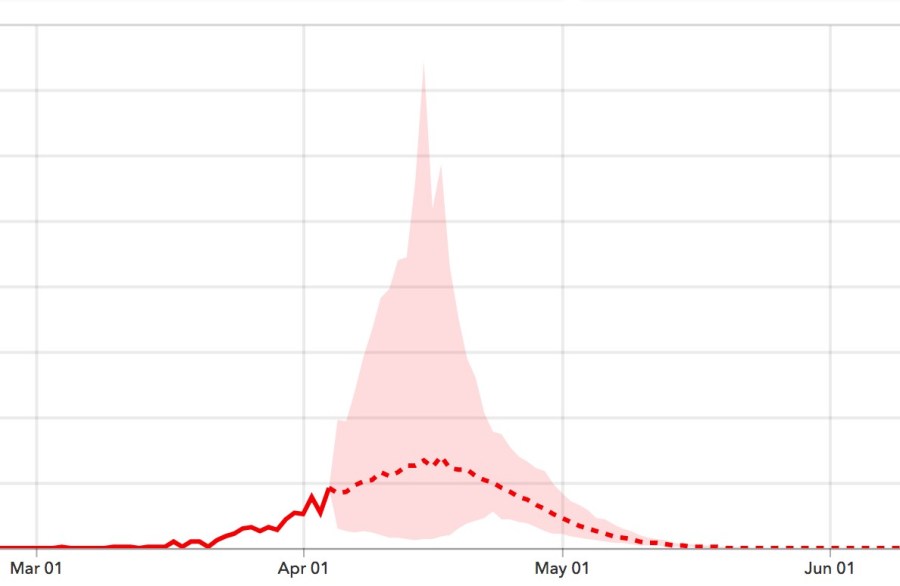California will see fewer deaths and hospitalizations due to the coronavirus pandemic than previously projected, with peak demand for health care resources now expected to happen sooner — but only if residents continue to follow physical distancing orders, according to a revised forecast released Sunday by researchers at the University of Washington’s medical school.
The latest state-by-state projections from the Seattle university’s Institute for Health Metrics and Evaluation revised the number of total COVID-19 deaths in the Golden State from more than 6,100 initially expected down to 1,783.
The number of daily deaths in California is expected to peak at 70 on April 17. That number of fatalities is less than half of estimates made when the institute’s projections were first released March 26.
Previously, a peak in California was predicted toward the end of April.
To date, California has 14,336 confirmed cases and 343 deaths, according to numbers that were released by Gov. Gavin Newson on Monday.

While the modeling has been updated daily since being published, the latest numbers reveal a somewhat dramatic shift from just six days ago — the reflection of “a massive infusion of new data,” Dr. Christopher Murray, the institute’s director, said in a news release.
That data is coming from multiple states, California among them.
And it’s not just the Golden State that has seen a big shift. The estimated peaks in various states have also changed as researchers looked at the effects of social distancing in seven locations across Italy and Spain, both of which have been hit hard by the virus.
“As we obtain more data and more precise data, the forecasts we at IHME created have become more accurate,” Murray said.
Across the U.S., there will also be less of a need for hospital and ICU beds to deal with the outbreak than earlier figures showed, according to the institute. But there will still be an estimated shortage of roughly 36,654 hospital beds, including 16,323 ICU beds.
About 25,000 ventilators will be needed nationwide at the epidemic’s peak, down from an estimated 26,753 a week ago.

The length of patients’ hospital stays has shortened recently, but that may be due to some moderately ill patients not being admitted because of an overwhelming demands for beds at certain hospitals, like in New York, according to researchers.
Conversely, those who end up in intensive care end up are staying longer, something that is influencing and increasing demand for ICU beds and ventilators.
Nationwide, the institute’s number of estimated fatalities in the U.S. dipped slightly in the past week, from 82,141 to 81,766. The range is 49,431 to 136,401; last week it was between 39,174 to 141,995.
Fatalities across the country are projected to peak on April 16, with 3,130 deaths estimated for that date, according to the forecast.
The U.S. total death toll topped 10,000 on Monday.
Nearly 38% of the the total deaths are expected in three states: New York, New Jersey and Connecticut. Researchers referred to the tri-state area as a “national hot spot.”
New York’s potential peak could come within a few days, followed later by New Jersey.
Murray noted that the forecast assumes physical distancing measures will remain in place until at least the end of May, and that the numbers could shift in the wrong direction if people stop adhering.
“The trajectory of the pandemic will change — and dramatically for the worse — if people ease up on social distancing or relax with other precautions,” he said. “Our projections are strengthened by the new downturns in more regions. This is evidence that social distancing is crucial.”
The latest estimates assume that states with social distancing measures in place will continue to enforce them through the end of May, while the few that don’t will implement such regulations within the next week, according to Murray.
“If social distancing measures are relaxed or not implemented, the US will see greater death tolls, the death peak will be later, the burden on hospitals will be much greater, and the economic costs will continue to grow,” he said.
California, which was first to enact a statewide stay-at-home order when Gov. Newson issued it March 19, is expected to see its peak hospital resource use on April 15, one day ahead of the national average, according to the institute’s projections.
It appears the Golden State will still have the necessary resources in place to meet the demands, as was the case in previous projections. The institute does not predict there will be a hospital or ICU bed shortage in the state, even if California reaches its worst-case scenario.
At the apex, the state will need 688 ventilators, which it already has on hand.
As of Monday, California has seen 2,509 hospitalizations due to COVID-19, with 1,085 patients placed in intensive care.
The state’s own dynamic modeling indicates the peak may not happen until mid-May, according to Newsom. In preparation for that, the state has been working to increase hospital bed capacity by 50,000, Newsom said last week.
California had more than 11,000 ventilators on hand as of Monday, Newsom said. The state has loaned about 500 out to the national stockpile so that federal authorities could distribute them to states that are in dire need.
“CA will continue to prepare and secure the equipment we need to keep our fellow Californians healthy while standing with other states in their moments of need,” the governor tweeted Monday in announcing the move.
Los Angeles County, meanwhile, plans to unveil its own forecasting model later this week, according to Dr. Christina Ghaly, director of the county’s Department of Health Services. She warned the model has limitations.
“What the model will never be able to do is exactly predict a peak. It will paint, through a range of potential scenarios, a band in which we might anticipate that there would be a peak,” she said. “But then that model is continually updated with the data from the previous day on testing, hospitalization rates so that we can determine which point on the curve and which of those scenarios we are closest to.”
L.A. County, which has the highest concentration of coronavirus cases in the state, reported another significant increase of patients Monday, bringing the total number of cases to 6,360.
The county currently accounts for more than a third of all COVID-19 fatalities in the state.
Health officials warn that the week ahead will be a critical one in the fight to contain the novel coronavirus, and are telling residents to avoid even going to grocery stores and pharmacies if they can to slow the spread.
“We will see many more cases over the next few weeks,” said Dr. Barbara Ferrer, the county’s public health director. “If you have enough supplies in your home, this will be the week to skip shopping altogether.”












